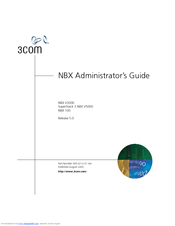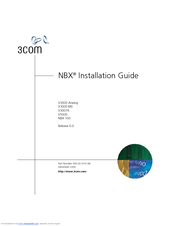3Com SuperStack 3 V5000 Network Switch Manuals
Manuals and User Guides for 3Com SuperStack 3 V5000 Network Switch. We have 3 3Com SuperStack 3 V5000 Network Switch manuals available for free PDF download: Administrator's Manual, Installation Manual, Release Note
3Com SuperStack 3 V5000 Administrator's Manual (482 pages)
3Com NBX 100: User Guide
Brand: 3Com
|
Category: Telephone System
|
Size: 4 MB
Table of Contents
-
2 Dial Plan
29 -
-
-
-
-
-
T1.231 Near End223
-
T1.231 Far End224
-
TR54016 Near End224
-
TR54016 Far-End224
-
G.826 Near End224
-
G.826 Far End225
-
-
-
Users227
-
Call Pickup228
-
Group Numbers228
-
-
Hunt Groups235
-
Page Zones240
-
Account Codes241
-
-
-
System Settings249
-
Audio Settings257
-
Date and Time263
-
Timers263
-
Ringing Patterns264
-
IP Addresses266
-
Speed Dials267
-
-
Business Hours268
-
System Mode269
-
TAPI Settings270
-
Disk Mirroring271
-
-
-
-
ACD Agent List276
-
ACD Licenses276
-
Using ACD278
-
ACD Groups279
-
ACD Agents282
-
ACD Statistics283
-
-
-
7 Nbx Messaging
297-
Group List297
-
NBX Voice Mail298
-
Status306
-
Port Usage307
-
User Usage308
-
Auto Attendant308
-
-
Statistics328
-
-
8 Operations
333-
Software Upgrade333
-
Considerations336
-
Customer Service337
-
Reboot/Shutdown337
-
Manage Data338
-
Migration338
-
Migrating Data339
-
Restore343
-
Convert Database344
-
Purge Database344
-
-
Event Log344
-
Licenses345
-
-
9 Reports
351-
Directory351
-
Device List352
-
System Data352
-
Disk Status352
-
-
Call Reporting353
-
-
10 Downloads
355 -
-
Using H3Pingip372
-
-
Overview399
-
Creating Option400
-
-
WAN Router404
-
-
Special Issues423
-
-
Gateway Checks429
-
Network Checks430
-
Network Ping430
-
-
Placing Calls434
-
IP Address Entry434
-
Speed Dials436
-
-
Receiving Calls438
-
Auto Attendant439
-
Other Extensions439
-
-
-
Caller ID
441-
-
External Calls443
-
Internal Calls445
-
Nortel Phones445
-
Parked Calls445
-
TAPI Calls445
-
VTL Calls445
-
-
Auto Redial448
-
Delayed Ringing452
-
Error Detection453
-
Fast Ethernet453
-
Hybrid Mode455
-
Phantom Mailbox460
-
Thin Ethernet464
-
Twisted Pair464
-
Advertisement
3Com SuperStack 3 V5000 Installation Manual (248 pages)
3Com NBX 100: Installation Guide
Brand: 3Com
|
Category: Telephone System
|
Size: 3 MB
Table of Contents
-
Introduction
21 -
-
Introduction80
-
-
-
Analog Lines
139 -
Analog Devices
143 -
-
-
-
-
Troubleshooting
193 -
Specifications
199-
-
Safety200
-
EMC Emissions200
-
EMC Immunity200
-
Other Approvals200
-
-
NBX Hub Card210
-
NBX Uplink Card211
-
-
Uidelines for
229 -
Upport for
233
Advertisement
Advertisement
Related Products
- 3Com 3CR17562-91 - Switch 4500
- 3Com 3824 - SuperStack 3 Switch
- 3Com 3C17302A-US - Switch 4200
- 3Com 3C16981A-US - Superstack 3 Switch 3300 12port10/100
- 3Com 3CB9E7 - CoreBuilder 9000 Chassis Switch
- 3Com 3CNJ1000PSL-US - NJ1000/NJ2000 Local Ac-to-dc 48V Power Supply
- 3Com 3C17502
- 3Com SuperStack 3 Switch 3300 SM
- 3Com 3C17705
- 3Com 3C16870


